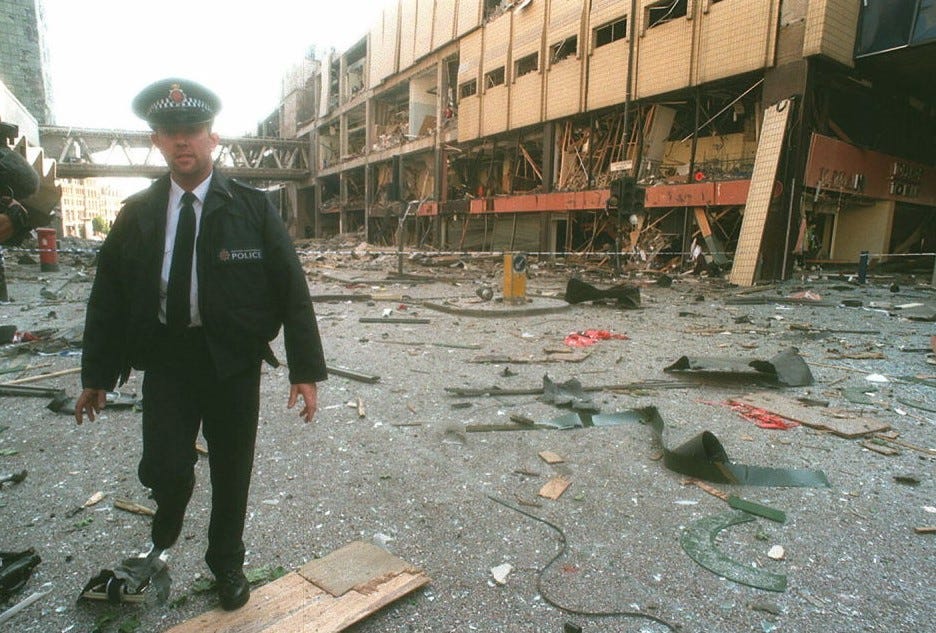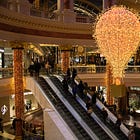Everyone hates the Arndale, but it's a microcosm of Manchester
‘We’ll be doing over a million footfall a week’
By Jack Dulhanty
There’s a part of the Arndale — sequestered below the food court, outside the upstairs entrance to Boots — that’s lit entirely by fluorescence. The shops here, minus Boots and an Argos, are all independently owned: nail salons, barbers, vape shops and fancy dress places. In the centre of this little precinct within a shopping centre are some benches and extra tables for food court diners. Shop owners come out and lean in their doorways like they’re getting fresh air.
I found myself here on Wednesday as I walked around the Arndale taking big bites out of a chocolate pretzel. An elderly man was eating a sandwich out of the packaging the loaf came in. A girl on her break from Boots was drinking coffee and scrolling TikTok. A man was having lunch with his adult son. Two girls were eating churros from a place called Churros Loco (they serve churros in upside-down sombreros) but decided they didn't like them and gave them to a stranger sitting on the same bench. They briefly filmed him eating them then walked away.
While other parts of the Arndale have grand names — Exchange Court, New Cannon Street, Winter Garden, Halle Place — this corner remains anonymous. “Us shops that don’t make as much don’t seem to matter as much to the Arndale,” says Caitlin, who works in a fancy dress shop called Duty Free, which dresses many of the Gay Village’s drag queens. “They’re all getting the coolest things from here. The wigs, the tutus, whatever they need to make their costumes.”
If the Arndale appears in your mind as one homogeneous shopping centre squatting on the city centre like a giant toad, you have not been looking closely enough. Parts of it are forgotten; some parts are rich and varied; others are modern but bland. It even has, as Caitlin points out, its own little north-south divide. The Arndale doesn’t just exist in the middle of Manchester — it’s a microcosm of the city too.
The lost district
“You have to align the development of the Arndale with the development of Manchester,” David Allinson, the centre’s CEO tells me. “It has grown so strongly, and that relationship has been symbiotic.” Allinson is right. The respective developments are aligned, and equally lopsided.
The Arndale started construction in 1972 and opened in phases between 1976 and 1979. It was the last of three local buildings designed by Wilson and Womersley architects, after Hulme Crescents and the Manchester Education Precinct. “One that was red (the Precinct), one grey (the Crescents), one yellow (the Arndale),” says Richard Brook, a professor in architecture at Lancaster University, when I call him from the Arndale food court. “Three huge, significant megastructures. You could say they changed the face of the city in education, commerce and housing.”
The area the Arndale replaced was a historic part of the city: a warren of alleyways and side streets unchanged since the 1700s, so narrow some corners were barely reached by sunlight, and home to an ungovernable mess of pubs, clubs and shops. “It was really a very thriving community of all sorts of things, both people living there and earning their living,” says Keith Warrender, a historian who wrote a book on the subject: Manchester’s Lost District, Life Before the Arndale.
Nowadays, demolishing something like that would be impossible. It’d be like bulldozing the Shambles in York. But back in the 60s? “I think there were 50 official letters sent to resist it,” Warrender says. The council didn’t see how its narrow streets were suitable for modern retail (i.e. the model of American malls that imposed order and comfort onto the previously unruly retail experience).
It cost £100 million to build (about half a billion in today’s money), and on 15 June 1996, a huge swathe of it was destroyed by the largest peace-time bomb to be detonated in Britain. One Mill member recalls being late for a martial arts exhibition being held at the centre that day. Instead, they went to look at the wreckage. Glass was everywhere, as were the yellow tiles that covered the building's exterior. Phil Griffin, The Mill’s resident architecture writer, has one as a paperweight.

The centre took the brunt of the damage from the bomb, and those around it suffered the worst injuries. As former MEN editor Mike Unger wrote for The Mill about that day, one woman who had been working overtime at an insurance company a 100 yards from the bomb “was standing on the bridge across the street linking M&S and the Arndale. She’d heard the warnings but decided to take a look just as the nearby bomb exploded. She was severely cut by the glass windows on the bridge and 10 years later she was still finding glass in her face.”
After the bomb, there was a race to rebuild the city centre and the Arndale. There was the threat of the newly announced Trafford Centre, which would open in 1998, taking over as Greater Manchester’s premier shopping destination. Five teams were short-listed to lead the redevelopment. Some teams put forward plans to replace the wrecked building. The team that was chosen — a consortium of engineers, planners, builders and architects, including Ian Simpson, one half of the dominant city centre architecture firm SimpsonHaugh — were more conservative, deciding to rebuild and extend parts of the Arndale instead.
This rebuild focused around the north section, partly for expediency. As the Independent reported, “the city wants to get back on its feet as quickly as possible. The judges’ choice has made it clear that what was wanted was a team and a design that could give birth to a new centre on a tight budget and in the shortest possible time.”
The parts that came after the bomb are those that some employees at the Arndale now bemoan as being favoured by management: Exchange Court, New Canon Street and Winter Garden, with some of that curious affluence trickling out to Halle Place, which was developed in 2018. It’s as if the bomb and the rebuild fractured the Arndale into two time zones. In fact, one long-term employee of a shop I spoke to recently (who asked not to be named) actually referred to that part of the centre, where you’ll find the Apple store and Victoria’s Secret, as the “post-bomb side”.
The city’s inflection point
This uneven development is partly what gives the Arndale its varied texture. There’s the pre-bomb side with more discount stores, the post-bomb side, and then the market (which is owned and operated by the council, while the rest of the centre is owned by M&G Real Estate and managed by CBRE). In this way, one corner of the centre can feel entirely different to another, with different businesses and therefore customers, demographics and age groups. Different parts also have different uses. I saw one man sitting on a bench reading outside Duty Free, where it’s much quieter than, say, Winter Garden. When I looped back nearly 40 minutes later, he was still there.
In her book Meet me by the Fountain: The Inside History of the Mall the architecture critic Alexandra Lange argues that malls are not just retail monoliths but centres of culture. They are often designed to reflect the kind of public space the average high street shopper would recognise, with avenues and plazas and gardens. But many of these malls are out-of-town in the suburbs (think: the Trafford Centre). If you’re going there, you’re likely only going there. By contrast the Arndale (which would likely be referred to — quite dryly — as an urban enclosed shopping mall, or inner-city shopping centre) is embedded into the city.
It’s a shortcut for when you just can’t face Market Street buskers. It's a slaughterhouse for time. It’s somewhere to just get out of the rain. And, whether you think it’s a brutalist marvel, hotbed of flash-mobbing anti-social behaviour or just a bit naff, you can’t deny its popularity. 95% of its shops are full and Allinson tells me it is expected to top 40 million visits this year alone, comfortably back to pre-pandemic levels.
And now Christmas is coming. “We’ll be doing over a million footfall a week,” Allinson tells me, in the frosted glass boardroom we meet at in Arndale House. The bulk of the planning for Christmas — planning for how people will flow around the centre, picking out Christmas decorations and deciding where they will go — was actually done in March. Despite the prevailing notion that most Christmas shopping is done online nowadays and brick-and mortar stalls don’t get much of a look-in, Allinson says: “it is still the most important time of the year.”
The Arndale acts as an inflection point for all facets of Mancunian society. Whether it’s the teams of builders I saw at Rowntrees Café, the teenagers that spend all day in the food court, the foodies buying karela or okra from the fruit and veg stalls at the market or the couple watching the fishmonger bash frozen prawns apart. One turning to the other to ask “what’s that” and the other replying “battered fish, do you get it?”
This time last year, I wrote about the Trafford Centre, arguing that the out of town, palazzo-style shopping centre was soulless. The Arndale has no such problem. Its character is undeniable because, in some way or another, it’s our character too.











How nice to read a human interest story that doesn't feel like the output of a corporate PR department!
A really good local interest story. I really like the Arndale, it's grown on me over the years since I moved to Manchester in 1991. It's clean, bright and has a great selection of shops. Always cheers me up when I visit. Well maintained public loos if you are caught short as well.